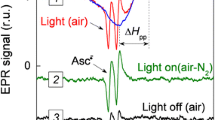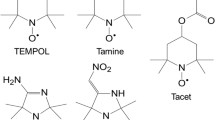Abstract
A methyl viologen (MV)* mediated Mehler reaction was studied using Type C and D chloroplasts (thylakoids) from spinach. The extent of photooxidative reactions were measured as (a) rate of ethylene formation from methional oxidation indicating the production of oxygen radicals, and (b) rate of malondialdehyde (MDA) formation as a measure of lipid peroxidation. Without added ascorbate, 1 μM FerricEDTA increased ethylene formation by greater than 4-fold, but had no effect on MDA production. Ascorbate (1 mM) produced a tripling of ethylene while it reduced MDA formation in the presence of iron. Radical scavengers diethyldithiocarbamate (DDTC), formate, 1,4-diazabicyclo (2.2.2octane) (DABCO), inhibited ethylene formation. Using 0,4 M mannitol to scavenge hydroxyl radicals, the rates of ethylene formation were reduced 40 to 60% with or without 1 μM Fe(III) EDTA. The strong oxidant(s) not scavenged by mannitol are hypothesized to be either alkoxyl radicals from lipid peroxidation, or ‘site specific’ formation of hydroxyl radicals in a lipophillic environment not exposed to mannitol. Singlet oxygen does not appear to be a significant factor in this system. Catalase strongly inhibited both ethylene and MDA synthesis under all conditions; 1 mM ascorbate did not reverse this inhibition. However, the strong superoxide dismutase (SOD) inhibition of ethylene and MDA formation was completely reversed by 1 mM ascorbate. This suggests that superoxide was functioning as an iron reducing agent and that in its absence, ascorbate was similarly promoting oxidations. Therefore, these oxidative processes were dependent on the presence of H2O2 and a reducing agent, suggesting the involvement of a Fenton-type reaction.
Similar content being viewed by others
Abbreviations
- DABCO:
-
1,4-diazabicyclo(2.2.2.octane)
- DCMU:
-
3-(3′,4 Dichlorophenyl). 1,1′-dimethyl urea
- DDTC:
-
diethyldithiocarbamate
- EDTA:
-
ethylenediamine-tetraacetic acid
- MDA:
-
malondialdehyde
- MV:
-
methyl viologen
- SOD:
-
superoxide dismutase
- TBA:
-
thiobarbituric acid
- TCA:
-
trichloroacetic acid
References
Anderson RF and Patel KB (1978) The effect of 1,4-diazabicyclo [2.2.2]-octane on the radiosensitivity of bacteria. Photochem and Photobiol 28:881–885
Arnon DI (1949) Copper enzymes in isolated chloroplasts. Polyphenol oxidase in Beta vulgaris. Plant Physiol 20:1–15
Aust SD and Svingen BA (1982) The role of iron in enzymatic lipid peroxidation. In Pryor W (ed) Free radicals in biology, vol. V, pp 1–28 New York: Academic Press, Inc
Sadger MR (1985) Photosynthetic oxygen exchange, Ann Rev Plant Physiol 36:27–53
Beauchamp C and Fridovich I (1970) Mechanism for the production of ethylene from methional. The generation of the hydroxyl radical by xanthine oxidase. J Biol Chem 245:4641–4646
Borg DC et al. (1984) Autooxidative cytotoxicity: is there metal-independent formation of hydroxyl radicals? Are there ‘crypto-hydroxyl radicals? In Bors W, Saran M, and Tait D (eds) Oxygen radicals in chemistry and biology. pp 123–129. New York: Walter de Gruyter
Bors W et al. (1979) On the nature of biochemically generated hydroxyl radicals. Studies using the bleaching of p-nitrosodimethylaniline as a direct assay method. Eur J Biochem 95:621–627
Bors W et al. (1979) Superoxide anions do not react with hydroperoxides. FEBS Letters 107:403–406
Bors W et al. (1980) The nature of intermediates during biological oxygen activation. In Bannister WH and Bannister JV (eds) Biological and clinical aspects of superoxide and superoxide dismutase, pp 1–31. New York: Elsevier/North-Holland
Bors W et al. (1981) Organic oxygen radicals in biology generation and reactions. In: Rodgers M and Powers E (eds) Oxygen and oxy-radicals in chemistry and biology. pp 75–81. New York: Academic Press
Buege JA and Aust SD (1978) Microsomal lipid peroxidation. In Colowick SP and Kaplan NO (eds) Methods in enzymology Vol 52c:302–310. New York: Academic Press
Cohen G and Sinet PM (1980) Fenton's reagent-once more revisisted. In Bannister JV and Hall HAO (eds) Chemical and biochemical aspects of superoxide and superoxide dismutase, Vol. IIA pp. 27–37. New York: Elsevier/North Holland
Dorfman LM and Adams GE (1973) Reactivity of the hydroxyl radical in aqueous solutions. In NSRDS-NBS 46, pp 1–59. Washington: National Bureau of Standards, US Department of Commerce
Elstner EF and Heupel A (1973) On the decarboxylation of α-keto acids by isolated chloroplasts. Biochim Biophys Acta 325:182–188
Elstner EF and Konze JR (1974) Light-dependent ethylene production by isolated chloroplasts. FEBS Lett 45:18–21
Elstner EF Saran M Bors W and Lengfelder E (1978) Oxygen activation in isolated chloroplasts. Mechanism of ferredoxin-dependent ethylene evolution from methionine. Eur J Biochem 89:61–66
Fee J (1980) Is superoxide toxic? In Bannister JV and Hall HAO (eds) Chemical and biochemical aspects of superoxide and superoxidedismutase, Vol IIA, pp 41–48. New York: Elsevier/North Holland
Foote CS (1976) Photosensitized oxidation and singlet oxygen: consequences in biological systems. In Pryor W (ed) Free radicals in biology vol. II, pp 85–133. New York: Academic Press
Foyer C Rowell J and Walker D (1983) Measurement of the ascorbate content of spinach leaf protoplasts and chloroplasts during illumination. Planta 157:239–244
Furbank RT Badger MR Osmond CB (1982) Photosynthetic oxygen exchange in isolated cells and chloroplasts of C3 plants. Plant Physiol 70:927–931
Girotti AW and Thomas JP (1984) Superoxide and hydrogen peroxide-dependent lipid peroxidation in intact and triton-dispersed erythrocyte membranes. Biochem Biophys Res Comm 18:474–480
Gutteridge JMC and Wilkins S (1982) Copper-dependent hydroxyl radical damage to ascorbic acid. Formation of thiobarbituric acid-reactive product. FEBS Lett 132:327–330
Halliwell B (1975) Hydroxylation of p-coumaric acid by illuminated chloroplasts. Eur J Biochem 55:355–360
Halliwell B (1978a) Superoxide-dependent formation of hydroxyl radicals in the presence of iron chelates. FEBS Lett 92:321–326
Halliwell B (1982) Ascorbic acid and the illuminated chloroplast. In Seib PA ed. Ascorbic acid:chemistry, metabolism and uses, pp 263–274. New York: Am Chem Soc.
Hosein B and Palmer G (1983) The kinetics and mechanisms of oxidation of reduced spinach ferredexin by molecular oxygen and its reduced products. Biochim Biophys Acta 723:383–390
Hossain et al. (1984) Monodehydroascorbate reductase in spinach chloroplasts and its participation in regeneration of ascorbate for scavenging hydrogen peroxide. Plant and Cell Physiol 25:385–395
Klebanoff SJ and Rosen H (1978) Ethylene formation by polymorphonuclear leukocytes; role of myeloperoxidase. J Exp Med 148:490–506
Kutsuki H and Gold MH (1982) Generation of hydroxyl radical and its involvement in lignin degradation by Phanerochaete chrysosporium. Biochem Biophys Res Comm 109:320–327
Lutz et al. (1973) Protection by diethyldithiocarbamate against carbon tetrachloride lethality in rats and against carbon tetrachloride-induced lipid peroxidation in vitro. Biochem Pharmacol 22:1729–1734
Marsho TV Behrens PW Radmer RJ (1979) Photosynthetic oxygen reduction in isolated intact chloroplasts and cells from spinach. Plant Physiol 64:656–659
McCord JM Day DD (1978) Superoxide-dependent production of hydroxyl radical catalyzed by iron-EDTA complex. FEBS Lett 86:139–142
McVetty PBE and Canvin DT (1982) Inhibition of photosynthesis by low oxygen concentrations. Can J Bot 59:721–725
Nakatani HY and Barber J (1977) An improved method for isolating chloroplasts retaining their outer membranes. Biochim Biophys Acta 461:510–512
Peiser GD and Yang SF (1978) Chlorophyll destruction in the presence of bisulfite and linoleic acid hydroperoxide. Phytochem 17:79–84
Powles SB Osmond CB and Thorne SW (1979) Photoinhibition of intact attached leaves of C3 plants illuminated in the absence of both carbon dioxide and of photorespiration. Plant Physiol 64:982–988
Pryor WA and Tang RH (1978) Ethylene formation from methional. Biochem Biophys Res Commun 81:498–503
Reeves SG and Hall DO (1980) Higher plant chloroplasts and grana. General preparative procedures (excluding high carbon dioxide fixation ability chloroplasts). In Colowick SP and Kaplan NO (eds) Methods in enzymology Vol 69, pp 85–94. New York: Academic Press
Rigo A Stevanato R Finazzi-Argo A and Rotilio G (1977) An attempt to evaluate the rate of the Haber-Weiss reaction by using OH radical scavengers. FEBS Lett 80:130–132
Saran M et al. (1983) Formation and reactivities of alkoxy radicals. In Cohen G and Greenwald R (eds) Oxy radicals and their scavenger systems. Vol I: Molecular Aspects, pp 20–25
Shinar E et al. (1983) The analogous mechanisms of enzymatic inactivation induced by ascorbate and superoxide in the presence of copper. J Biol Chem 258:14778–14783
Sawyer DT Gibian MJ (1979) The chemistry of the superoxide ion. Tetrahedron 35:1471–1481
Takahama U and Nishimura M (1976) Effects of electron donor and acceptors, electron transfer mediators, and superoxide dismutase on lipid peroxidation in illuminated chloroplast fragments. Plant & Cell Physiol. 17:111–118
Thomas MJ et al. (1982) The role of superoxide in xanthine oxidase-induced autooxidation of linoleic acid. J Biol Chem 257:8343–8347
Walling C (1975) Fenton's reagent revisited. Acc Chem Res 8:125–131
Weinstein J and Bielski BHJ (1979) Kinetics of the interaction of HO2 and O2 radicals with hydrogen peroxide. The Haber-Weiss reaction. J Amer Chem Soc 101:58–62
Winterbourn CC (1979) Comparison of superoxide with other reducing agents in the biological production of hydroxyl radicals. Biochem J 182:625–628
Winterbourn CC (1981b) Hydroxyl radical production in body fluids. Role of metal ions, ascorbate and superoxide. Biochem J 198:125–131
Winterbourn CC (1983) Lactoferrin-catalyzed hydroxyl radical production. Additional requirements for a chelating agent. Biochem J 210:15–19
Author information
Authors and Affiliations
Additional information
Scientific contribution number 1315 from the New Hampshire Agriculture Experiment Station.
Rights and permissions
About this article
Cite this article
Upham, B.L., Jahnke, L.S. Photooxidative reactions in chloroplast thylakoids. Evidence for a Fenton-type reaction promoted by superoxide or ascorbate. Photosynth Res 8, 235–247 (1986). https://doi.org/10.1007/BF00037131
Received:
Revised:
Accepted:
Issue Date:
DOI: https://doi.org/10.1007/BF00037131




